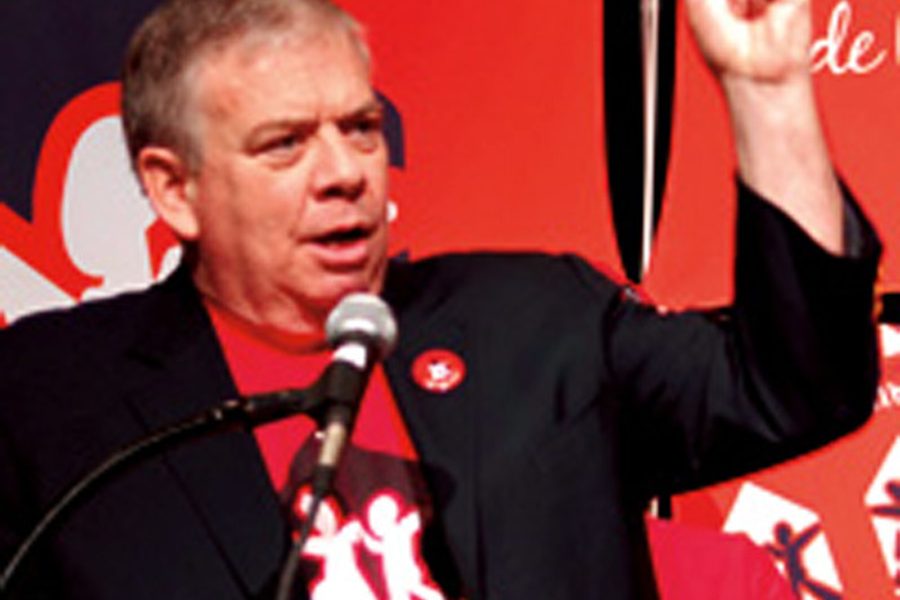Solidarity Reunited?
Unions rally around shrunken UNITE HERE as it takes on its former ally.
David Moberg

CHICAGO – A square plaque in the pavement outside the Sheraton Chicago hotel commemorates the formation of the UNITE HERE union here five years ago. That event was an exuberant, optimistic celebration of the merger of the traditional hotel (HERE) and apparel (UNITE) unions.
UNITE HERE’s second convention at the same hotel this week was not so celebratory: Much of the old UNITE union broke away earlier this year with the active collaboration and support of the Service Employees International Union (SEIU), which then absorbed the breakaway units.
But UNITE HERE president John Wilhelm and delegates seemed optimistic, even as they face a battle with their erstwhile ally, SEIU, over members, money and the right to organize traditional HERE industries.
A three-front battle
Wilhelm thinks UNITE HERE will prevail in a three-front battle with contentious employers, a rotten economy and the “company union” (as they label SEIU) by focusing the union’s fight on companies, strengthening members’ involvement in the union and rallying support from other unions and allies.
The moves UNITE HERE announced at its convention, held from June 29 to July 1, do seem to strengthen its hand as it takes on SEIU, which is much richer and roughly eight times its size.
Other union leaders are upset about the nasty, distracting fight, which broke into the open late last year and has intensified as SEIU tries to hold or take away many of HERE’s old workplaces and to encroach on its core industries – hotels, gaming and food services.
Mediation by United Food and Commercial Workers President Joe Hansen failed. And at the convention, UNITE HERE formally rejected SEIU’s recent proposal for binding arbitration to settle the conflict.
“It’s like somebody robs a bank and gets caught,” Wilhelm said of the SEIU proposal, and “then suggests submitting to arbitration how much they can keep.” Also, SEIU risks nothing in arbitration, Wilhelm noted, while the future of UNITE HERE would be up for grabs.
SEIU insists the proper analogy is the break-up of a marriage of two unions. But Warren Pepicelli, president of a traditionally UNITE New England regional body who did not join his colleagues in leaving UNITE HERE, said that SEIU was involved in the early planning meetings for a break-up prior to the convention.
Wilhelm says he is willing to negotiate, but SEIU will have to give up plans to organize in HERE’s core industries and equitably resolve financial issues between the two unions. That would include returning money that Wilhelm says was improperly spent by former president Bruce Raynor, who is now president of Workers United, the SEIU group of former UNITE HERE groups that split away.
But a negotiated settlement anytime soon is “a long shot, a very long shot,” UNITE HERE vice-president Jim DuPont says.
In many ways, UNITE HERE leaders see their union as holding the upper hand. They are convinced, for example, that they will win a lawsuit in federal court over control of the union’s assets, including Amalgamated Bank. A hearing is scheduled for mid-July, but legal battles could drag on.
Meanwhile, Wilhelm says the union has access to only $4 million of its $333 million in assets because Raynor tied up the remainder in various ways – such as investing most of the union’s strike fund in Amalgamated stock – without Wilhelm’s approval.
Wilhelm believes Raynor, and ultimately SEIU, may also be vulnerable to charges of a “criminal conspiracy to steal $23 million” from the union.
UNITE HERE officials say Raynor made payments of $10 million to units of the union – units that were preparing to break away – without the constitutionally required signature from Wilhelm, and in violation of fiduciary responsibilities to protect the union. (UNITE HERE reports talking with federal authorities, but no charges have been filed.)
Union reunion
UNITE HERE has also been drumming up support in the labor movement in its battle with SEIU and its president, Andy Stern. Fourteen major labor leaders, plus the AFL-CIO building trades unions, signed a statement of solidarity and support for UNITE HERE.
Statement signers pledged to help “both materially and morally, against a raid by any union against Unite Here members, or workers in Unite Here’s industry jurisdictions.” They also pledged support “if any employer seeks to take advantage of the current situation.”
The signers include the presidents of all the big unions – except SEIU – in the Change to Win federation, which UNITE HERE co-founded, as well as major AFL-CIO unions such as the Teachers, Steelworkers, Communications Workers and AFSCME (state, county and municipal workers).
Additionally, at least two dozen local labor councils have passed similar resolutions of support for UNITE HERE against SEIU. And the top three officers of the AFL-CIO condemned raids against UNITE HERE by any union.
At the convention, AFSCME president Gerald McEntee accused SEIU of “piracy,” Operating Engineers President Vincent Giblin referred to Stern as the “Darth Vader of the labor movement,” and Laborers president Terry O’Sullivan bluntly rejected SEIU’s arbitration proposal and wondered aloud what union SEIU might next try to raid. Giblin promised financial support for any UNITE HERE workers forced into a strike or lock-out.
Labor at a crossroads?
Perhaps the workplaces where SEIU is trying to take over traditional HERE units are the most important front in the fight. UNITE HERE claims that SEIU is committing large numbers of organizers, often apparently with some support from management, to efforts to decertify UNITE HERE, challenge UNITE HERE in organizing drives, or simply take over local unions.
Ann Marie Taliercio is president of a 450-member former HERE local in Syracuse, N.Y., that had affiliated with a historically UNITE regional body, called a joint board.
Taliercio’s joint board broke with UNITE HERE, but her local wanted to remain in the merged union. She says the joint board, as part of SEIU, took over her office and locked it, throwing out her files. Although SEIU claims to represent the workers, she says members are still loyal to UNITE HERE, and employers continue to recognize her local.
Banquet cook Clarence Richardson said that hotel human relations officials at Houston’s Hilton Americas hotel, where she works, allowed SEIU organizers into the hotel to organize against UNITE HERE.
In most cases, it appears that UNITE HERE is winning these battles for members’ loyalty by building bigger committees of supporters at the workplace. It is positioning itself as a stark alternative to SEIU – more democratic, more decentralized, more encouraging of member control, and more willing to fight at contract time and in the workplace for higher standards.
As Wilhelm said, UNITE HERE wants to be seen as the bottom-up, aggressive alternative to SEIU, which he described as the top-down, cheap contract union.
“Now we find the labor movement at a crossroads,” Wilhelm told the convention. “There’s a top-down strategy that stifles creativity and begs employers to let us organize. That strategy requires, by definition, crushing union democracy. Look at the turmoil in SEIU. The labor movement can’t succeed with a top-down strategy.”
As part of that strategy, the convention amended the constitution to place more checks on the power of the president, Wilhelm, and to protect local union autonomy (including control over mergers of locals and the right to independent arbitration of proposed trusteeships of locals).
The union institutionalized racial and gender diversity in its leadership and established local and regional elections for the majority of governing board members. It passed a bill of rights for all members, including specific proposed rights for members of Service Workers United, a problematic joint national local whose members belong to both UNITE HERE and SEIU.
The changes may strengthen UNITE HERE’s appeal to members. Richardson, for example, said she picked UNITE HERE to represent her because she opposes concentration of power in a union.
“UNITE HERE gives people the opportunity to disagree,” she said. “With a good healthy debate, it gives us the opportunity to get what we want as working people.”
SEIU has a huge staff and greater financial resources. If legal battles drag on, it would gain an edge against UNITE HERE. Although other unions now overwhelmingly side with UNITE HERE against SEIU raiding, there will be pressure on both sides to settle.
But before that happens, the war could escalate, as SEIU has threatened and Wilhelm anticipates. He told delegates that their union is already stronger, and the convention suggests it is still gaining strength. A confident Wilhelm said, “We will prevail.”
UPDATE: SEIU spokeswoman Michelle Ringuette said July 9 that “[d]espite its claims to the contrary, UNITE HERE is certainly aware that we are not interested in raiding them.” SEIU, however, accuses UNITE HERE of raiding, because it has contested whether the breakaway units that joined SEIU can legally represent workers in industrial laundries and other workplaces. On July 7, Andy Stern wrote to his union’s executive board, saying that SEIU is not interested in “organizing hotel or gaming workers generally” and still wants an arbitrator to resolve the conflict.
David Moberg, a former senior editor of In These Times, was on staff with the magazine from when it began publishing in 1976 until his passing in July 2022. Before joining In These Times, he completed his work for a Ph.D. in anthropology at the University of Chicago and worked for Newsweek. He received fellowships from the John D. and Catherine T. MacArthur Foundation and the Nation Institute for research on the new global economy.








